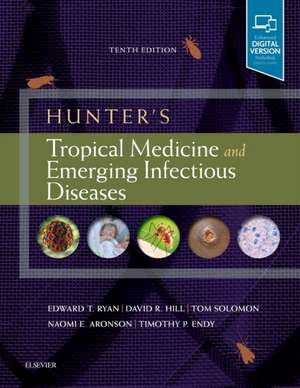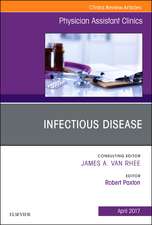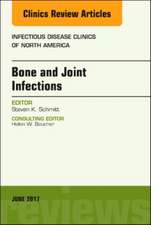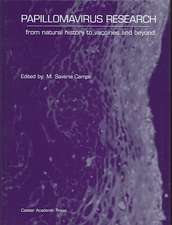Hunter's Tropical Medicine and Emerging Infectious Diseases
Autor Edward T Ryan, David R. Hill, Tom Solomon, Naomi Aronson, Timothy P Endyen Limba Engleză Hardback – 21 mai 2019
Preț: 973.49 lei
Preț vechi: 1256.39 lei
-23% Nou
186.29€ • 193.39$ • 155.34£
Carte disponibilă
Livrare economică 22 februarie-08 martie
Specificații
ISBN-10: 0323555128
Pagini: 1264
Ilustrații: Approx. 600 illustrations (500 in full color)
Dimensiuni: 216 x 276 x 65 mm
Greutate: 3.61 kg
Ediția:10
Editura: Elsevier
Cuprins
Part 1 - CLINICAL PRACTICE IN THE TROPICS - all editors
Section A: ORGAN-BASED CHAPTERS
1. Tropical Lung Diseases
2. Cardiovascular Diseases
3. Gastrointestinal Diseases
4. Hepatobiliary Diseases
5. Hematologic Diseases
6. Genitourinary Diseases
7. Sexually Transmitted Infections
8. Tropical Dermatology
9. Ophthalmological Diseases
10. Neurologic Diseases
11. Psychiatric Diseases
12. ENT
13. Diseases of the Musculoskeletal System
Section B: SKILLS-BASED CHAPTERS
14. General Surgery in the Tropics
15. Oral Health and Disease in the Tropics
16. Maternal and Newborn Health
17. Pediatrics in a Resource-constrained Setting
Section C: SERVICE-BASED CHAPTERS
18. Diagnostic Imaging in the Tropics
19. Blood Transfusion in Resource-limited Settings
20. Infection Control in the Tropics
21. Microbiology
Section D: TOPIC-BASED CHAPTERS
22. Approach to the Patient with Diarrhea
23. Cancer in the Tropics
24. Heat-associated Illness
25. Traditional Medicine
26. Environmental Health Hazards in the Tropics
27. Neglected Tropical Diseases: Public Health Control Programs and Mass Drug Administration
28. Health Systems and Health Care Delivery
29. The Health Care Response to Disasters, Complex Emergencies, and Population Displacement
Part 2: Viral Diseases
Introduction and General Principles
30. Human Immunodeficiency Virus Infection
30.1 HIV, Tuberculosis, Malaria and Streptococcus pneumoniae
31. Viral Infections with Cutaneous Lesions
31.1 Measles
31.2 Poxviruses
31.3 Nonpolio Enterovirus Mucocutaneous Infections
31.4 Kaposi's Sarcoma-associated Herpesvirus
32. Viral Respiratory Infections
33. Viral Gastroenteritis
33.1 Rotavirus
33.2 Norovirus
33.3 Enteric Adenoviruses
33.4 Astroviruses
33.5 Sapovirus
34. Viral Hepatitis (Hep A, B, C, D, E and Non A to E)
35. Viral Febrile Illnesses and Emerging Pathogens
35.1 Dengue and Dengue Hemorrhagic Fever
35.2 Chikungunya Fever
35.3 Zika
35.4 O'nyong Nyong Fever
35.5 Ross River Virus Disease
35.6 Oropouche Virus
35.7 Mayaro Virus
35.8 Pathogenic Phleboviruses (old: Sandfly Fever)
35.9 Sindbis Fever
36. Viral Hemorrhagic Fevers - INTRODUCTION
36.1 Yellow Fever
36.2 Lassa Fever
36.3 South American Hemorrhagic Fevers
36.4 Ebola and Marburg Virus Infections
36.5 Crimean-Congo Hemorrhagic Fever
36.6 Diseases Caused by Hantaviruses
36.7 Rift Valley Fever
37. Viral CNS Infections
37.1 Rabies & Related Viruses
37.2 Enterovirus Infections That Cause Central Nervous System Disease (including Poliomyelitis)
37.3 Venezuelan, Eastern and Western Equine Encephalitis
37.4 Japanese Encephalitis
37.5 West Nile Virus
37.6 Saint Louis Encephalitis and Rocio Encephalitis
37.7 Other Arboviral Encephalitides
37.8 Prion Disease
37.9 Human T-Lymphotropic Virus Type I and II Infection
PART 3: BACTERIAL INFECTIONS
Section A: Infections of the Eye and Throat
38. Trachoma and Inclusion Conjunctivitis
39. Group A Strepto coccus
40. Diphtheria
Section B: Respiratory Tract Infections
41. Bacterial Pneumonia
42. Tuberculosis
43. Pertussis
Section C: Gastrointestinal Tract Infections
44. Helicobacter pylori Infection
45. Escherichia coli Diarrhea
46. Cholera and Other Vibrios
47. Shigellosis
48. Nontyphoid Salmonella Disease
49. Campylobacter Infections
50. Miscellaneous Bacterial Enteritides
50.1 Yersinia Enterocolitica
50.2 Clostridium Infections
50.3 Aeromonas
Section D: Sexually Transmitted Diseases
51. Chlamydial Infections
52. Lymphogranuloma Venereum
53. Gonorrhea
54. Chancroid
55. Granuloma Inguinale
56. Syphilis and the Endemic Treponematoses
Section E: Infections Causing Neurologic Manisfestations
57. Acute Bacterial Meningitis
58. Tetanus
59. Botulism
Section F: Infections of Skin and Soft Tissues
Bacterial skin and soft tissue infections in the Tropics
60. Leprosy
61. Buruli Ulcer
62. Mycobacterium marinum Infection
63. Anthrax
Section G: Febrile Systemic Syndromes with or without Lymphadenopathy
64. Epidemic Louse-borne Typhus
65. Murine Typhus
66. Scrub Typhus
67. Tick-borne Spotted Fever Rickettsioses
68. Rickettsialpox
69. Q Fever
70. Trench Fever
71. Bartonellosis : Carrion's Disease and other Bartonella Infections
72. Typhoid and Paratyphoid (Enteric) Fever
73. Brucellosis
74. Melioidosis and Glanders
75. Plague
76. Tularemia
77. Leptospirosis
78. Relapsing Fever and Borrelioses
Part 4 - The Mycoses
79. General Principles
80. Superficial Mycoses
81. Subcutaneous Mycoses : General Principles
82. Protothecosis
83. Histoplasmosis
84. Coccidioidomycosis
85. Blastomycosis
86. Paracoccidioidomycosis
87. Cryptococcosis
88. Penicilliosis Marneffei
89. Pneumocystis Pneumonia
90. Treatment of Systemic Mycoses
Part 5 - Protozoal Infections
91. General Principles
Section A: Intestinal and Genital Infections
92. Entamoeba histolytica (Amebiasis)
93. Giardiasis
94. Cryptosporidiosis
95. Cyclosporiasis
96. Cystoisospora belli (syn. Isospora belli )
97. Miscellaneous Intestinal Protozoa
98. Trichomoniasis
Section B: Infections of the Blood and Reticuloendothelial System
99. Malaria
100. African Trypanosomiasis
101. American Trypanosomiasis (Chagas disease)
102. Leishmaniasis
103. Babesiosis
Section C: Tissue Infection
104. Toxoplasmosis
105. Pathogenic and Opportunistic Free-living Ameba Infections
106. Sarcocystosis
107. Microsporidiosis
Part 6 - Helminthic Infections
108. General Principles
Section A: Intestinal Nematode Infections
109. Nematodes Limited to the Intestinal Tract ( Enterobius vermicularis , Trichuris trichiura , Capillaria philippinensis and Trichostrongylus spp.)
110. Intestinal Nematodes: Ascariasis
111. Hookworm and Strongyloides Infections
Section B: Filarial Infections
112. Lymphatic Filariasis
113. Loiasis
114. Onchocerciasis
115. Miscellaneous Filariae
Section C: Other Tissue Nematode Infections
116. Dracunculiasis
117. Trichinellosis
118. Toxocariasis
119. Gnathostomiasis
120. Eosinophilic Meningitis ( Angiostrongylus cantonensis , Parastrongylus cantonensis )
121. Abdominal Angiostrongyliasis
122. Cutaneous Larva Migrans
123. Anisakidosis
Section D: Trematodes Infections
124. Schistosomiasis
125. Intestinal Fluke Infections
126. Liver Fluke Infections
127. Paragonimiasis
Section E: Cestode Infections
128. Tapeworm Infections
129. Larval Cestode Infections (Cysticercosis)
130. Cystic Echinococcosis
131. Alveolar Echinococcosis (Alveolar Hydatid Disease)
132. Polycystic Echinococcosis (Polycystic Neotropical Disease)
133. Sparganosis
134. Coenuriasis
Part 7 - Poisonous and Toxic Plants and Animals
135. Animals hazardous to humans: Venomous Bites, Stings and Envenoming
136. Injurious Arthropods
137. Poisonous Plants and Aquatic Animals
138. PENTASTOMIASIS
139. BATS
Part 8 - Nutritional Problems and Deficiency Diseases
140. General Principles
141. Protein-energy Malnutrition in Children
142. Vitamin Deficiencies
143. Mineral Deficiencies
Part 9 - Vector Transmission of Diseases and Zoonoses
Section A: Medical Entomology
144. Introduction medical Entomology
Section B: Diseases associated with Vectors (Arthropods in Disease Transmission)
145. Diseases associated with Vectors (Arthropods in Disease Transmission)
Section C: Vector Control
146. Vector Control
Part 10 - The sick returning traveller
147. General Principles
148. Fever in the Returned Traveler
149. Malaria in the Returned Traveler
150. Screening of the Asymptomatic Long-term Traveler
151. Persistent Diarrhea in the Returned Traveler
152. Skin Lesions in Returning Travelers
153. Eosinophilia in Migrants and Returned Travelers: A Practical Approach
154. Immigrant Medicine
155. International Adoption
156. Medical Tourism
157. Transplant Patients and Tropical Diseases
158. Delusional Parasitosis
Part 11 - Laboratory Diagnosis of Parasitic
159. General Principles
159.1 Preparation of Samples for Morphologic Diagnosis of Parasites in Stool and Urine Specimens
159.2 Examination of Blood, Other Body Fluids, Tissues, and Sputum
Part 12: Drugs used in Tropical Medicine
160. Albendazole
161. Artemisinin
162. Benznidazole
163. Dapsone
164. DEC
165. Eflornithine
166. Ivermectin
167. Mebendazole
168. Miltefosine
169. Nifurtimox
170. Nitazoxanide
171. Pentamidine
172. Pentavalent Antimony
173. Praziquantel
Descriere
New emerging diseases, new diagnostic modalities for resource-poor settings, new vaccine schedules . all significant, recent developments in the fast-changing field of tropical medicine. Hunter's Tropical Medicine and Emerging Infectious Diseases, 10th Edition, keeps you up to date with everything from infectious diseases and environmental issues through poisoning and toxicology, animal injuries, and nutritional and micronutrient deficiencies that result from traveling to tropical or subtropical regions. This comprehensive resource provides authoritative clinical guidance, useful statistics, and chapters covering organs, skills, and services, as well as traditional pathogen-based content. You'll get a full understanding of how to recognize and treat these unique health issues, no matter how widespread or difficult to control.












